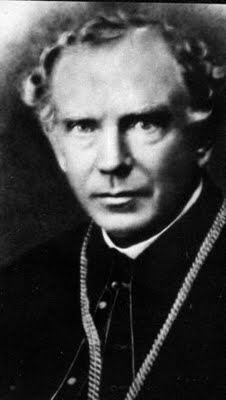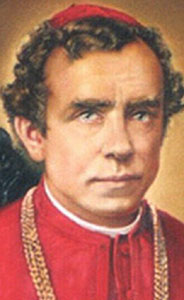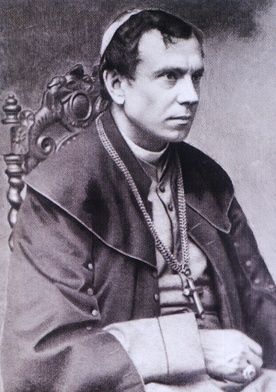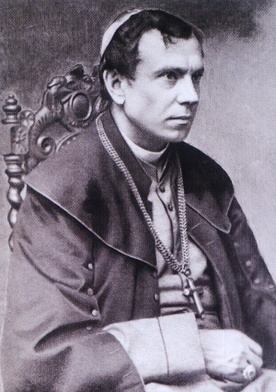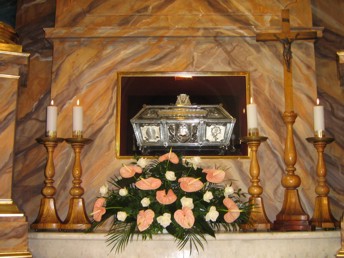∼Also known as
Sigmund Felix Felinski; Sigismondo Felice Felinski; Sigismond Felix Felinski; Zygmunt Szczesny Felinski; Zygmunt Szczêsny Feliñski
Memorial
17 September
Profile
Son of Gerard Felinski and Eva Wendorff, the third of six childen in a proudly patriotic Polish family. Two of his siblings died as children, and his father died when Sigimondo was 11 years old. His mother was arrested and exiled to Siberia in 1838 for her pro-Polish politics and for working to improve the economic conditions of farmers.
Sigimondo studied mathematics at the University of Moscow from 1840 to 1844, and French literature at the Sorbonne and College de France from 1847. There he became friends with Polish emigres, writers and nationalists, and involved in the failed revolt of Poznan in 1848. Tutor to the Brzozowski family in Munich and Paris from 1848 to 1850. Entered the diocesan seminary of Zytomierz, Poland in 1851, and then studied at the Catholic Academy of Saint Petersburg. Ordained on 8 September 1855. Assigned to the Dominican parish of Saint Catherine of Siena in Saint Petersburg 1855 to 1857. Spiritual director and professor of philosophy of the Ecclesiastical Academy. Founded the charitable group Recovery for the Poor in 1856. Founded the Congregation of the Franciscan Sisters of the Family of Mary in 1857.
Archbishop of Warsaw, Poland on 6 January 1862, arriving there on 9 February 1862. The city had been under a state of seige by the Russians since 1861, and the churches had been closed for months. On 13 February 1862 Sigismond reconsecrated the cathedral of Warsaw, and on 16 February he re-opened all the city's churches. Warsaw continued in upheaval with regular clashes between Russian and Polish nationalist forces. He reformed parish life, revitalized charities, revamped the seminary teaching, worked to free imprisoned priests, helped start parochial schools and an orphanage, and though he worked for elimination of government meddling in the Church, the Russians circulated the rumour that Sigismondo was a spy, undermining his authority.
Following the bloody repression of the Russians of the January Revolt of 1863, Sigimond resigned from the Council of State, wrote to Emperor Alexander II urging an end to violence, and protested against the hanging of the Capuchin Father Agrypin Konarski, chaplain of the "rebels". In return, he was deported to Jaroslavl, Siberia on 14 June 1863 where he spent 20 years in exile. In the camps he worked to organize the priests and charitable work among his felow prisoners, even building a church.
Lengthy negotiations between Moscow and the Vatican resulted in Sigimondo being freed in 1883. On 15 March 1883, Pope Leo XIII transferred him to the titular see of Tarsus where he lived his final 12 years in semi-exile in southeastern Galizia at Dzwiniaczka ministering to Ukranian and Polish peasants, building a church, parochial school, and a convent for the Franciscan Sisters of the Family of Mary.
Born
1 November 1822 in Volinia, Poland (formerly in Russia; now in Ukraine)
Died
17 September 1895 in Krakow, Poland of natural causes; buried in Krakow on 20 September 1895; relocated to Dzwiniacza on 10 October 1895; remains translated to the crypt of the Cathedral of Saint John, Warsaw, Poland on 14 April 1921
Beatified
18 August 2002 by Pope John Paul II at Krakow, Poland
Canonized
pending
∼Also known as
Sigmund Felix Felinski; Sigismondo Felice Felinski; Sigismond Felix Felinski; Zygmunt Szczesny Felinski; Zygmunt Szczêsny Feliñski
Memorial
17 September
Profile
Son of Gerard Felinski and Eva Wendorff, the third of six childen in a proudly patriotic Polish family. Two of his siblings died as children, and his father died when Sigimondo was 11 years old. His mother was arrested and exiled to Siberia in 1838 for her pro-Polish politics and for working to improve the economic conditions of farmers.
Sigimondo studied mathematics at the University of Moscow from 1840 to 1844, and French literature at the Sorbonne and College de France from 1847. There he became friends with Polish emigres, writers and nationalists, and involved in the failed revolt of Poznan in 1848. Tutor to the Brzozowski family in Munich and Paris from 1848 to 1850. Entered the diocesan seminary of Zytomierz, Poland in 1851, and then studied at the Catholic Academy of Saint Petersburg. Ordained on 8 September 1855. Assigned to the Dominican parish of Saint Catherine of Siena in Saint Petersburg 1855 to 1857. Spiritual director and professor of philosophy of the Ecclesiastical Academy. Founded the charitable group Recovery for the Poor in 1856. Founded the Congregation of the Franciscan Sisters of the Family of Mary in 1857.
Archbishop of Warsaw, Poland on 6 January 1862, arriving there on 9 February 1862. The city had been under a state of seige by the Russians since 1861, and the churches had been closed for months. On 13 February 1862 Sigismond reconsecrated the cathedral of Warsaw, and on 16 February he re-opened all the city's churches. Warsaw continued in upheaval with regular clashes between Russian and Polish nationalist forces. He reformed parish life, revitalized charities, revamped the seminary teaching, worked to free imprisoned priests, helped start parochial schools and an orphanage, and though he worked for elimination of government meddling in the Church, the Russians circulated the rumour that Sigismondo was a spy, undermining his authority.
Following the bloody repression of the Russians of the January Revolt of 1863, Sigimond resigned from the Council of State, wrote to Emperor Alexander II urging an end to violence, and protested against the hanging of the Capuchin Father Agrypin Konarski, chaplain of the "rebels". In return, he was deported to Jaroslavl, Siberia on 14 June 1863 where he spent 20 years in exile. In the camps he worked to organize the priests and charitable work among his felow prisoners, even building a church.
Lengthy negotiations between Moscow and the Vatican resulted in Sigimondo being freed in 1883. On 15 March 1883, Pope Leo XIII transferred him to the titular see of Tarsus where he lived his final 12 years in semi-exile in southeastern Galizia at Dzwiniaczka ministering to Ukranian and Polish peasants, building a church, parochial school, and a convent for the Franciscan Sisters of the Family of Mary.
Born
1 November 1822 in Volinia, Poland (formerly in Russia; now in Ukraine)
Died
17 September 1895 in Krakow, Poland of natural causes; buried in Krakow on 20 September 1895; relocated to Dzwiniacza on 10 October 1895; remains translated to the crypt of the Cathedral of Saint John, Warsaw, Poland on 14 April 1921
Beatified
18 August 2002 by Pope John Paul II at Krakow, Poland
Canonized
pending
Advertisement
Advertisement


